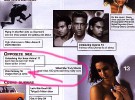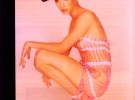Fictive Tear Sheet, 2000
Actual fashion shoot for the first issue of a new L.A. based Latin men’s magazine, incorporating fictional clothing.
Images of the magazine pages:
Fictive Tear Sheet-Project Description
The term “tear sheet” refers to a picture of a fashion designers work which appears in a magazine, and can then be torn out and displayed to show the designer is being successful.
This particular project happened quite serendipitously. The photographer Jo Lance stopped by the Fictive Studio in a quest for clothing to shoot for an upcoming fashion spread for a possible new magazine. Some of the Fictive fashion art caught his eye and after short initial hesitation we suddenly realized it was a fantastic opportunity to create a new work. Some items were manufactured expressly for Fictive Tear Sheet. Jo incorporated the Fictive pieces seamlessly into the shoot along with actual clothing from various other designers.
Little separates Fictive’s fashion art from regular clothing. It is usually an element of a larger artwork which is conceived as a whole. It often involves a performative aspect, and always has some conceptual element involved. One of the very few ways it differs is that it is not for sale as clothing. This is one of the only ways to keep it from spilling over the edge from conceptual into actual fashion.
A disclaimer is in order here. Unlike other recent Fictive work we didn’t first conceive the project and then find creative people to collaborate on it. This work is very ephemeral and after-the-fact. Most of the people involved were simply doing their regular jobs and had no idea we imagined ourselves to be creating an artwork. We never met the editors of the magazine. Jo was simply doing his normal work.
I think this relates in a variety of interesting ways to contemporary fashion. Half the time clothing chosen for a fashion shoot doesn’t even fit the model being used. Clips, clothes pins and other methods are employed to make the clothing look the right way. Photographers frame only elements they like. Stylists grab odd bits of stuff from home, off-the-shelves, or even find something lying around in an abandoned lot near the photo shoot (no lie). These elements are incorporated into the visual look without anyone ever mentioning that they are not for sale and in many cases not even pieces of clothing.
Runway shows are notorious for showing items that would never be ordered by buyers for later sale to the public. These articles function as centerpieces, giving a marketing impression, mood, or sense of how the more normal clothing should be perceived.
There is also a huge focus on the show itself, and designers often see their work entirely wihin this structure. The number of groups and the order of the clothing items down the runway is often being determined before the garments are even designed. One is not creating a variety of clothing items for people to wear so much as one is sculpting a strong show.
The special runway items, (often dear to the designers and essentially, artworks) will be available in the showroom along with all the other items after the runway event, and stylists can and do borrow them for photo shoots. Often they are sought out as the best pieces even if they will never see production.
Thus, between the stylists, photographers and the designers a lot of what one sees in magazines is actually fictional fashion art to begin with.
As you search the periodical literature for what’s hot, what’s now, who you should be, and what you could buy next, we hope you’ll look for a copy of H6K. Whether this new magazine ever actually sees the light of day, It’s an excellent resource for today’s Latin man, and a nice little piece of accidental contemporary art. – Paul Clay

